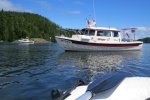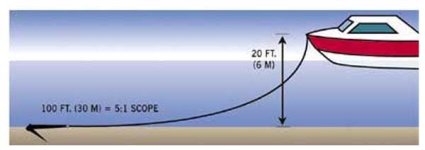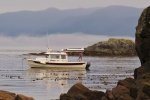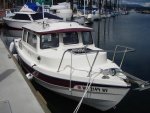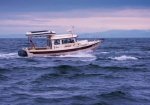The Trawler Forum just had a recent post about exactly how to calculate "scope." Turns out there isn't a clear definition. Some definitions include the distance from water to deck only once. Some definitions triple the water to deck distance in calculating scope. Some definitions ignore it and define scope as only what is in the water.
INCLUDE THE DISTANCE:
Boat US:
http://www.boatus.com/boattech/casey/34.htm
Scope is the ratio of the length of deployed anchor rode to the height of the bow chock above the seabed.
---
“Chapman Piloting Seamanship and Small Boat Handling 62ed” Hearst Marine Books, New York, page 254
Scope. The ratio of the length of the anchor rode to the vertical distance from the bow chocks to the bottom (depth plus height of bow chocks above the water).
---
“Knight’s Modern Seamanship Sixteenth Edition” Van Norstrand Reinhold New York, 1977 page 259
Scope: the length of chain measured from hawse to the anchor by which the ship rides is the scope.
---
Department of the Army Technical Manual TM 55-501 “Harbor Craft Crewman’s Handbook” 1958 page 68. A safe minimum anchor rode length in normal weather conditions is a 7 to 1 (rode length to depth) ratio, or 5 to 1 for an all chain rode. "Depth" in this case is the actual depth of the water at high tide, plus the height of the anchor hawser above the water's surface.
---
“Boating Skills and Seamanship Twelfth Ed.” US Coast Guard Auxiliary, page 4-21
To compute the “depth” add the distance from the water’s surface to the chock the line passes through on your boat to the actual depth of the water.
---
Rocna Anchors:
http://www.rocna.com/kb/Scope_vs_catenary
Scope on the other hand is the ratio between the length of rode deployed and the distance the boat is from the seabed (the height from the seabed to the bow-roller or hawse-pipe, not just depth).
---
“The Practical Encyclopedia of Boating: An A-Z compendium of seamanship, boat maintenance, navigation, and nautical wisdom”, by John Vigor, published by The McGraw-Hill Companies, Inc.
The term scope refers to the length of line or chain between the anchor and the boat’s bow relative to the depth of water in which the boat is anchored. Thus, a scope of 3 to 1 indicates that a boat lying in 10 feet of water has an anchor line 30 feet long. In fact, the scope is measured to the bow roller, so the distance from the bow to water level must be added to the depth of the water.
---
“Sportfish, Cruisers, Yachts Owner’s Manual” NMMA Inc page 46
The scope is technically defined as the ratio of the rode length to vertical distance from the bow to the sea floor
---
Fortress Anchors: :
http://www.fortressanchors.com/safe_anchoring.html
Scope is the length of anchor line relative to the distance from your boat’s deck to the sea bottom.
IGNORE THE DISTANCE:
From professional mariners site
https://standard-club.com/media/1751..._oct_09_v1.pdf The ‘scope’ of the cable is the ratio of the length of cable paid out to the depth of water.
---
The Small Boat Handbook, D. Richey, T. Y. Crowell, New York, 1979.
"The minimum scope is approximately seven or eight times the distance from the surface to the bottom of the water."
---
Boating Skills and Seamanship, US Coast Guard Auxiliary Tenth Edition, page 2-17. "Scope is the length of the anchor rode measured in units of water depth."
---
Or from the RYA.ORG.uk where depth is water depth only.
And on and on and on. Pick one or the other and go with it. Both are better than losing count of the chain markers or miscalculating the tide.
As to depth sounders, I knew that both of my prior owners had used the
CHITON for diving (the lazzerete had a rack for 10 SCUBA tanks). What I didn't realize is that both depth sounders on board were set to read the depth from the surface, not under the keel. Ask me how I know.
Mark

